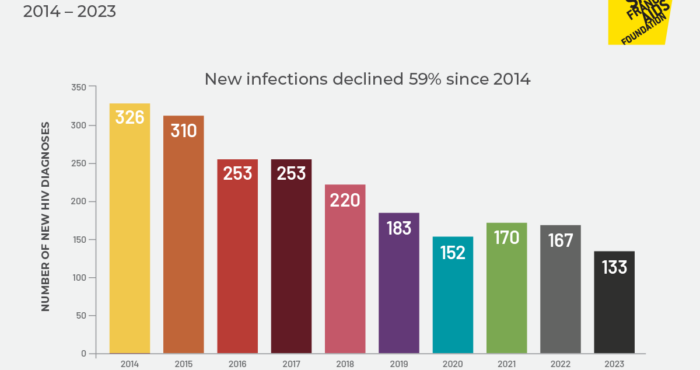What’s new in HIV: Updates on long-acting injections for prevention & treatment

For many years, we’ve relied on daily oral medications to treat HIV and to prevent HIV. But long-acting injectable options for both PrEP and treatment are an exciting new strategy that may increase acceptability, accessibility, and effectiveness. An injectable option is now available for both HIV treatment and PrEP, and new research is showing how PrEP and treatment injections may transform our response to the epidemic.
Long-acting injections for prevention
Late in 2021, the FDA approved the first long-acting injectable option for PrEP. Named Apretude®, the medication is a long-acting version of the integrase inhibitor cabotegravir, and is delivered as an injection once every two months. Long-acting injectable cabotegravir has no limitations on which groups can use this method of HIV prevention, which is notable given some early PrEP studies which failed to show efficacy with cisgender women.
“Those of you who followed the PrEP literature know that there’s been a lot of controversy about how well oral PrEP works for vaginal exposures in cisgender women,” said Raphael Landovitz, MD, MSc, professor of medicine at UCLA Center for Clinical AIDS Research & Education, during “State of the Science” presentation on injectable PrEP. “A lot of people at the beginning said, ‘It doesn’t work for women, it can’t work for women,’ And it turns out that’s not true.”
The problem, Landovitz explained, is that the medicine that’s used for oral PrEP (TDF/FTC, brand name Truvada), “doesn’t get into the tissues of the genital tract [for cisgender women] as well as it gets into rectal tissue. So you have to have much better adherence to daily oral products to get protection for vaginal exposures… You need to be pretty well perfect in your daily adherence to the oral PrEP to get the vaginal protection.”
Injectable options may be a game-changer–particularly for cisgender women and with other folks who may struggle with adherence. In the HPTN 084 study, researchers found an 89% reduction in HIV infections among cisgender women provided with injectable cabotegravir PrEP compared to those offered oral TDF/FTC.
“In my mind, this is stunning. It’s mind blowing,” said Landovitz.

A recent PrEP study, presented at the 2023 CROI by Sybil Hosek, PhD, showed that injectable long-acting cabotegravir for PrEP could be a feasible option for younger sexually active adolescent cisgender women (12 – 17 years old). The young women in the study had “exceptional” adherence to injection visits, were very interested in long-acting HIV prevention medication, and most (92%) chose to continue taking injectable cabotegravir for PrEP over PrEP oral medication when given a choice.
During a report-back on the study presentation for Getting To Zero San Francisco, Hyman Scott, MD, MPH, said that although injection site reactions (pain, swelling) were common in the study, no participants discontinued the study early because of these reactions and the frequency of reactions decreased over time.
In terms of acceptability, “a lot of the young women talked about receiving injections to protect against HIV being easier than other methods,” said Scott.
It is of note that researchers do not yet have much data on injectable PrEP with people who inject drugs, and transmasculine and non-binary people. “Those are huge gaps in our understanding of how to use this product,” said Landovitz.
With Black men who have sex with men and Black trans women disproportionately affected by HIV in the U.S., a recent study by Hyman Scott, MD, MPH, and colleagues looked at the efficacy of injectable cabotegravir for PrEP among U.S.-based Black and African American participants enrolled in the HPTN 083 study.
Cabotegravir PrEP worked even better to prevent HIV infections than oral PrEP. Over the course of the study, there were 15 infections among those taking oral PrEP, and only 4 infections among those receiving injectable PrEP.
“This showed that this [injectable cabotegravir PrEP] is a highly effective intervention in that we see a really decreased incidence among those who are taking CAB-LA [long-acting cabotegravir PrEP],” said Scott.
Unfortunately, cost and affordability may be one thing that prevents widespread uptake of long-acting cabotegravir PrEP.
“All the insurance companies are playing hot potato by making people go through all sorts of hoops and bells and whistles to use it [long-acting injectable PrEP]. And I’m really concerned, particularly outside of the US as well, that it’s not going to be implementable,” said Landovitz.
Long-acting injections for treatment
For HIV treatment, Cabenuva (cabotegravir/rilpivirine) has been available as a once-monthly injection since early 2021, and new studies are evaluating the benefits that long-acting injectable treatments offer.
In one study, presented at CROI by Moti Ramgopal, MD, people living with HIV who switched to an injectable treatment option shared reasons why they preferred injectable treatments over oral medications.
“The individuals who were taking the oral medications talked about some psychological social cycle issues, challenges with daily oral therapy,” said Dr. Scott. At the end of the study, 90% of participants preferred the injectable treatment option over daily oral medication, and reported benefits including “I don’t have to worry as much about remembering to take HIV medication every day,” and “I do not have to think about my HIV status every day.”
Another study presented at CROI by Monica Gandhi, MD, MPH, shared results from a real-world roll-out of injectable HIV treatment at the Ward 86 HIV Clinic in San Francisco. The clinic serves publicly insured people with high rates of mental illness (38%), substance use (39%), and unstable housing (34%), which may contribute to more difficulty in taking daily oral HIV medications.
Although more than 40% of people beginning injectable HIV treatment had detectable viral loads at the start of the study, nearly all (98%) achieved viral suppression. The vast majority of participants (74%) received on-time HIV treatment injections, and 100% of those who started the study virally suppressed remained virally suppressed during the study.
“This worked well within a patient population that included individuals who had not been virally suppressed,” said Scott. “I think this is going to be important as we move forward with the rollout of injectable treatment, as it shows that in a population that is more of a ‘safety net population,’ that you can have high success with this regimen.”
A final study that Dr. Scott highlighted during the Getting To Zero report-back addressed the question of whether injectable cabotegravir/rilpivirine could be administered in the thigh versus the gluteal (butt) muscle.
“If someone has gluteal implants, or gluteal injections in the gluteal region, then that’s a contraindication to administering medication in those sites,” he explained. Franco Felizarta and colleagues presented data from the ATLAS-2M study, which compared medication levels and patient preferences of thigh versus gluteal injections at CROI.
Levels of medication in the body were similar after thigh and gluteal injections, and about 30% of people preferred thigh injections over gluteal injections. Participants who preferred thigh injections said that the convenience and easy access to this site on the body was preferred. Thigh injection pain was frequently reported, however, after about 40% of all injections administered.
“Injection site reactions are variable. I think that the location in the thigh would make sense anatomically, but it might give you more symptoms,” said Scott.










